The Berkshires Bowling Alley that Inspired "The Big Lebowski"
It’s been 36 years since the release of The Big Lebowski, the irreverent cult comedy by Joel and Ethan


There’s something to be said about a city whose mayor gives historical kayaking tours in his spare time. Kingston, the latest “it” city in the Hudson Valley, is a showcase on how to seamlessly meld historical and hip. Preserved Dutch homes sit side by side with street art murals painted on former industrial buildings, and there’s a palpable buzz from the economic revival going on, much of which centers around the arts and food. But it’s a city that also never forgets its roots – with three landmarked historic districts and shipyards that are still active. It’s no surprise that New Yorkers, particularly Brooklynites, are flocking there in droves, perhaps looking for a version of New York City that once was.
So far, the transplants have been mostly welcomed and long-time residents understand the interest. “It’s a city, in the middle of the country,” says Karin Clark Adin who owns the shop “Bop to Tottom, Gifts with a Twist,” on Wall Street in the Stockade Historic District. Indeed, the long colonnade storefronts along Wall Street give Kingston almost a Wild Wild West outpost feel – until you look at the stores within.
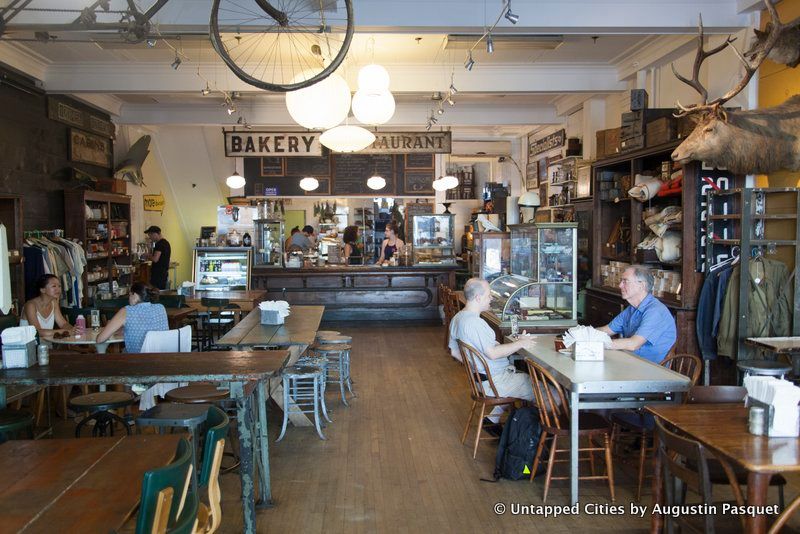
Interior of Outdated –An Antique Cafe
In a former Art Deco style bank is the headquarters of the Hudson Valley LGBTQ Community Center, half a block from the Old Dutch Church. A few doors down, Outdated is a wonderfully curated cafe and antique shop with many mid-century throwbacks for sale including vintage Crayola crayon boxes and black and white marble composition notebooks. Uptown Coffee serves paleo biscuits, scones and a variety of wraps and sandwiches.
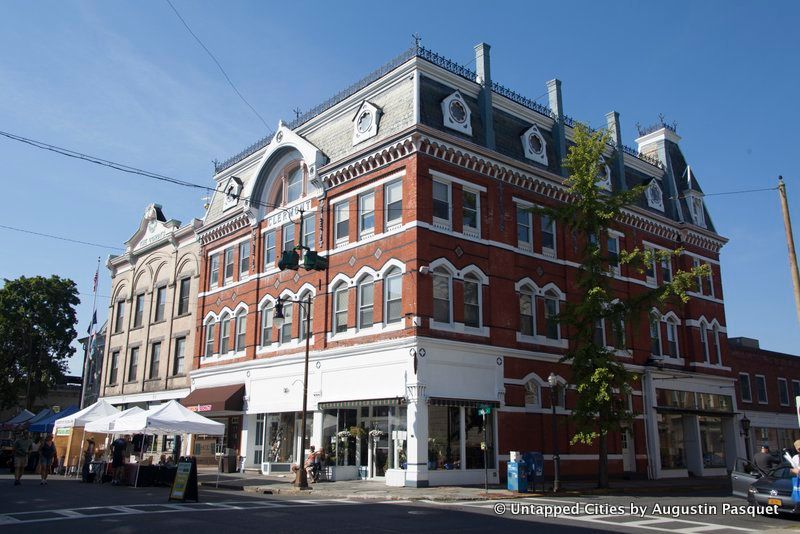
Clermont Building, on the corner of Wall Street and and John Street was built in 1878 with a distinctive mansard roof
Duo Bistro, located in the Clermont Building, just opened a shop selling local Hudson Valley products, like our latest discovery, Horseshoe Brand hot sauce run by two husband and wife duos. Redwood Bar & Restaurant has a rooftop deck with table and bar seating and Stella’s has been an Italian restaurant stronghold since 1975. There’s an ongoing project to reopen the former Woolworth store into a food hall, and every weekend, a farmers market takes over an entire stretch of Wall Street starting from the Old Dutch Church.

Fred J. Johnston Museum
The Friends of Historic Kingston give walking tours of this area, known as the Stockade Historic District, the largest intact early Dutch settlement in New York State. Highlights include The Ulster County Courthouse, where Sojourner Truth successfully sued to regain her son who had been sold a slave to a Southern slaveowner. Another must-see is the Federal style home of antiques dealer Fred J. Johnston, originally built by New York State Senator John Sudam. Johnston saved the house from demolition in 1938 and donated the house and his furniture collection. A gallery next door, also run by the Friends of Historic Kingston, showcases local history.

Ulster County Courthouse
You’ll notice that the streets in the Stockade Historic District sound quite similar to those in downtown Manhattan – Wall Street, Front Street, Maiden Lane, John Street. That’s because these streets were planned out by none other than Peter Stuyvesant, the Dutch director general of New Amsterdam. The streets remain in exactly the same pattern as they were laid out in 1658.

The O+ Festival brings renowned street artists to Kingston, who paint large scale murals on the city’s buildings. Right, one of the stone houses on the Four Corners. Backdrop of an O+ mural.
The Stockade District takes its name from the 14 foot tall wooden stockade walls built around this original street plan under the direction of Stuyvesant as protection against the Esopus Indians. Stuyvesant had also ordered the relocation of the Dutch settlers from the Esopus Creek, now the Rondout neighborhood, upland to an area that afforded more natural protection.

Two of the Four Corners, the only intersection in America with 18th century homes on all four corners
Within the Stockade Historic District is the Four Corners, at the intersection of John Street and Crown Street. This is the only intersection in America where 18th century homes stand on all four corners – all of them built of stone. More than 20,000 artifacts were found in the Matthewis Person House during a multi-year restoration and archeological study and the house remains in a state that deliberately reveals the history within.

Interior of Matthewis Person House
Around here, numerous other notable stone houses remain, including the headquarters for the Daughters of the American Revolution and more. But if you’re looking to spend more time immersed in an old Dutch home, grab lunch in the Hoffman House Restaurant and Tavern on North Front Street, which was built before October 1679 and is nearly entirely in its original structural form. Just down the street is another Dutch stone house, the Louw-Bogardus House, preserved as a ruin.
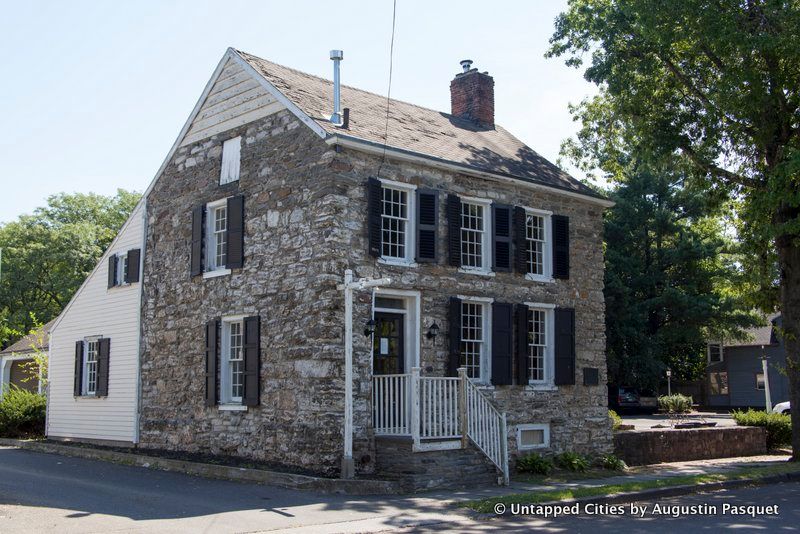
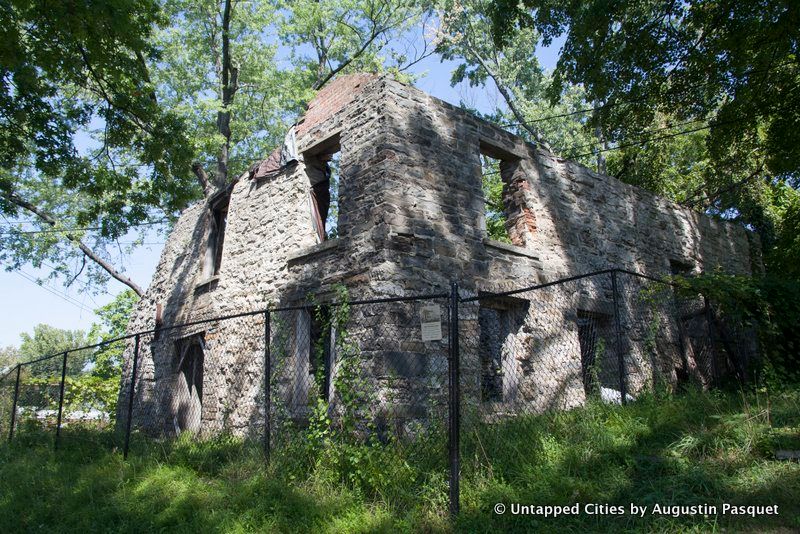
Louw-Bogardus House ruin
The Old Dutch Church is one of the storied locations where George Washington did indeed visit (there’s a signed letter from Washington graciously accepting the invitation to speak there). The church, founded in 1659, is an architectural gem by Minard LeFever, It was lauded by Calvert Vaux, one of the landscape architects for Central Park who proclaimed, “I cannot change a thing without impairing the exquisite unity. It’s ideally perfect.” A Louis Comfort Tiffany stained glass window, installed in 1891, is located behind the pulpit, and the Moeller Pipe Organ is one of the largest in the Hudson Valley. There’s also a small two-room Heritage Museum Archive inside, open by appointment with extensive geneological information, relics and old maps.
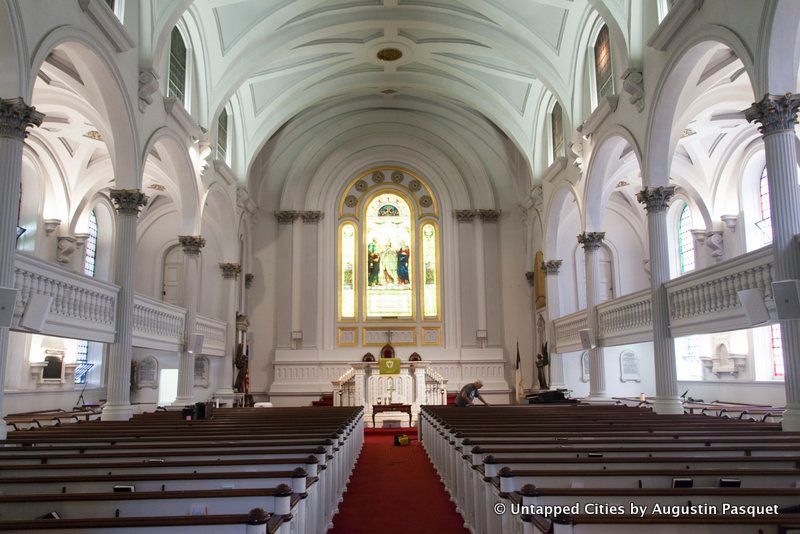
Old Dutch Church, interior
As the Old Dutch Church grew in congregation over time, it expanded atop part of the cemetery, and 80 graves still lie beneath the current structure. Numerous Revolutionary War heroes are buried in the cemetery at the Old Dutch Church, whose gravestones are marked by American flags. The most notable is George Clinton, who was the Brigadier General of the Revolution, the first governor of New York State, and Vice President of the United States under both Thomas Jefferson and James Madison. A celebrity even nearly 100 years after his death, the relocation of his body and accompanying 19-ton monument from his original burial site in Washington D.C. to Kingston in 1908 was followed by throngs of well wishers, tens of thousands strong.
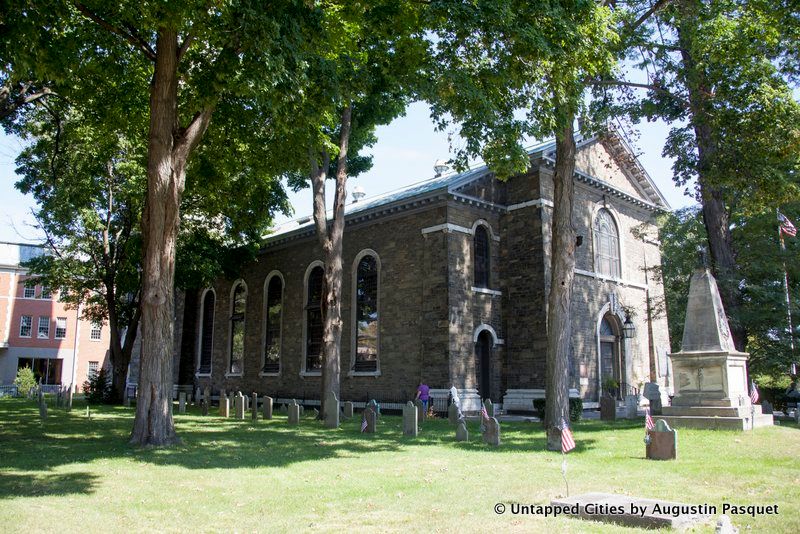
Old Dutch Church with monument and tombstone for George Clinton, on the right
Meanwhile, the Senate House State Historic Site is literally where the state of New York was born in 1777 in the Dutch stone home of merchant Abraham Van Gaasbeck. Within the overall historic site, you can visit this house, built in phases between 1676 and the 18th century, the Senate House Museum, and the Loughran House, an Italianate style home. You can take an informative tour, about one hour long, of the inside of the Senate House.
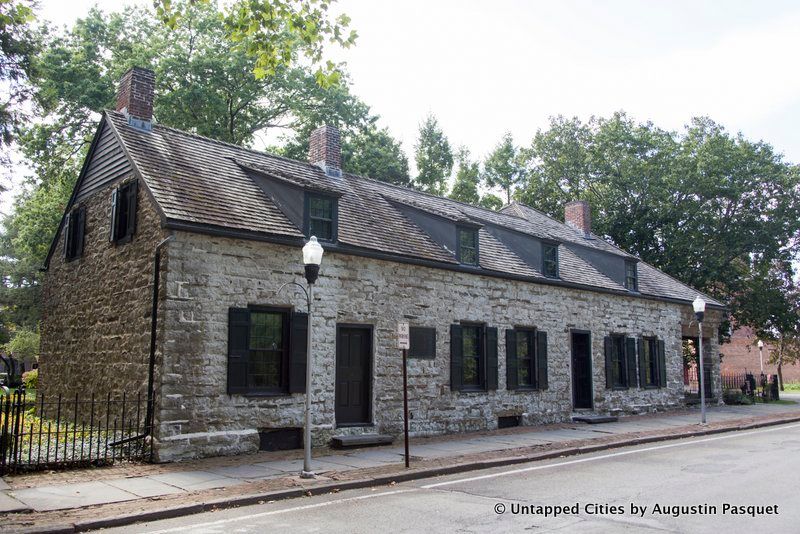
Senate House Historic Site
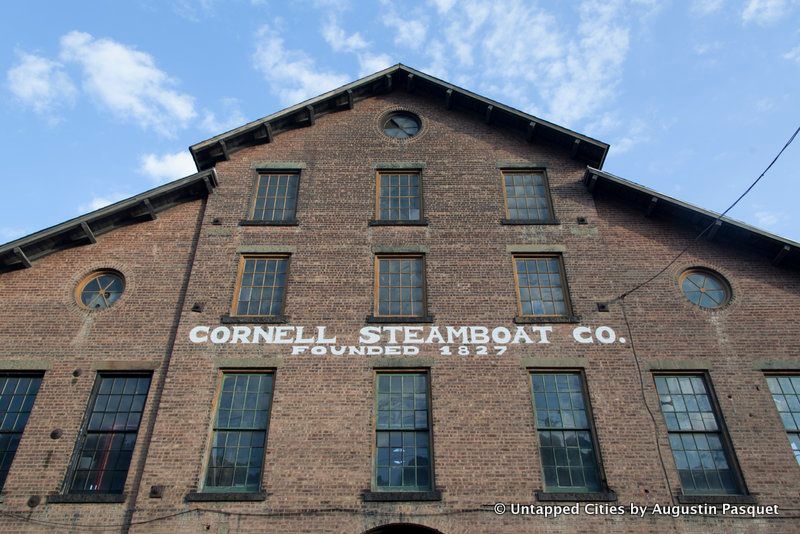
Moving forward in time and further south geographically, the Rondout Historic District showcases the industrial fervor of Kingston around the Rondout Creek, which leads out to the Hudson River. The first company to arrive was the Cornell Steamboat Company, founded by Thomas Cornell, and part of the once-thriving steamboat business along the Hudson River. Incidentally, the S.S. Columbia, the oldest steamboat still in existence will make its way to the Hudson Valley next year to be rehabilitated right along this riverfront in Kingston. The Clearwater, the Hudson River sloop built by Pete Seeger as an environmental flagship vessel was also restored in Kingston, which is the home base for the boat.

The Clearwater in the New York Harbor in July, soon after it was rehabilitated in Kingston
The industrial activity of the Roundout was bolstered by the D&H Canal, which transported 3 million tons of coal in the year 1870 alone, and the Kingston trolley system, built by the son-in-law of Thomas Cornell. Like many post-industrial places in America, the Roundout did not escape the fervor of urban renewal in the 1960s. The east side of the strand along the waterfront was demolished but fortunately the west side remained, offering a glimpse into what the 19th century maritime village would have looked like. Notable buildings include the former Sampson Opera House and the Mansion House, a luxury hotel. Up on a bluff is the Chestnut Street Historic District, lined with handsome mansions built by the affluent merchants of the Rondout.
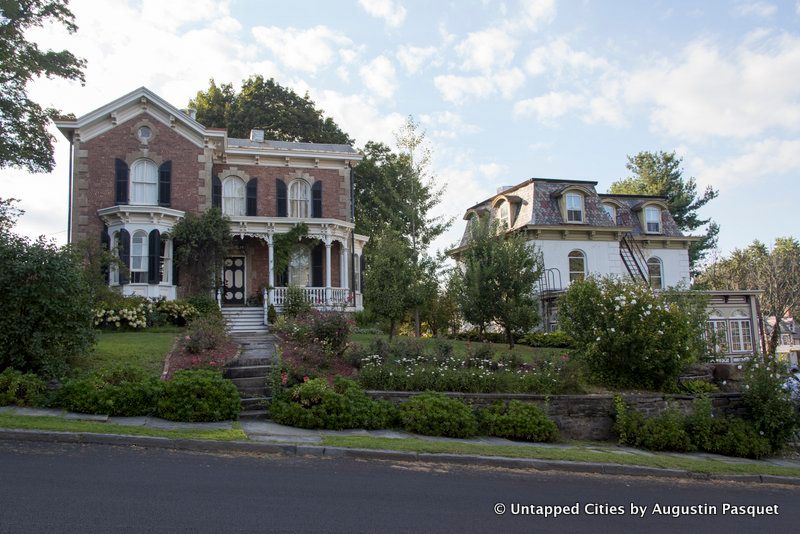
Mansions in the Chestnut Street Historic District
You can step inside the former Cornell Steamboat Company buildings by taking in a meal or drink at Ole Savannah, Southern Table & Bar which has outdoor seating along the creek. The Hudson River Maritime Museum is another place to take in the history of the Rondout. But besides the shipbuilding heritage, another highlight of the Rondout is the Trolley Museum of New York, located just across from Ole Savannah. Here you can see vintage trolleys, subways and rapid transit cars from all over the United States and Europe, and most notably recently, one of the last two PATH train cars from the World Trade Center on 9/11. (The other is located at the Shore Line Trolley Museum in East Haven, Connecticut).

Perhaps one of the most obvious connections in the Brooklyn to Kingston migration was the arrival of Smorgasburg, the famous Brooklyn food fair, in August this year. Smorgasburg Upstate, located in the abandoned Hutton Brickyards along ten acres of the Hudson River waterfront, features vendors from both Brooklyn and Hudson Valley purveyors, and mixes in elements from the Brooklyn Flea with a selection of vendors selling antiques, clothing and designs.
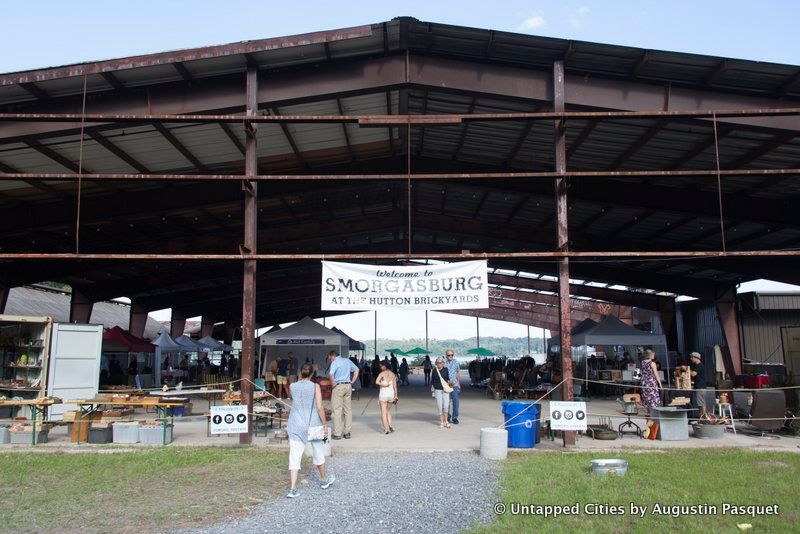
For those of the more outdoor bent, a great way to see the Rondout Creek is by kayak. A Day Away Kayak was founded by Kingston local Jesse Hicks, who started the business within his family’s marina as a teenager. He’ll point out a sunken, abandoned barge, remnants of an old D&H canal lock, and foundations of former bridge crossings. On our trip, amidst the stunning landscape, we sighted two bald eagles and a plethora of other wildlife.
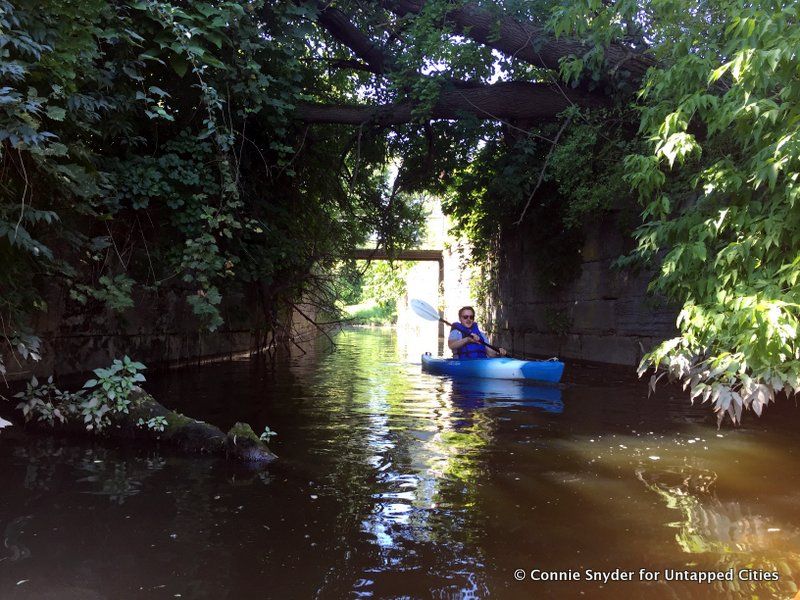
Kayaking inside a former D&H Canal lock, just off Roundout Creek
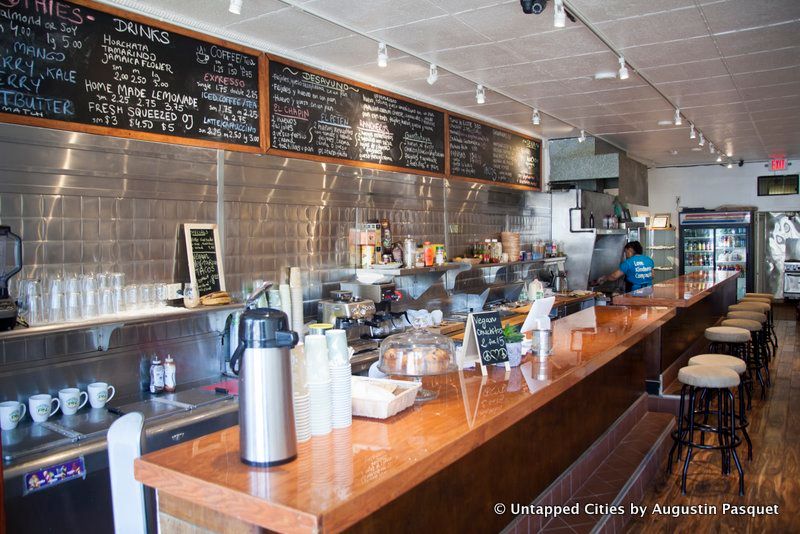
Peace Food Nation on Broadway in Mid-Town
The most exciting development area of Kingston may be Mid-Town, an area with Victorian houses and main commercial area just starting its economic recovery. It may also be the area closest to the Brooklyn of yesteryear – where affordable, industrial spaces were turned into meccas for artists and entrepreneurs. Peace Nation Cafe, an organic Guatemalan joint, is the newest addition along Broadway, operating out of a former luncheonette. The proprietor of Peace Nation, Noé del Cid was running a sustainable clothing and event company out of Brooklyn but moved all the operations to Kingston upon seeing the opportunities in real estate. He bought the building at 636 Broadway and decided to open a cafe in the ground floor space. But like all the other places we’ve visited in Kingston, it’s the community that seems to keep people here, in addition to the irresistible sense of optimism pervading the city. Down the street, in an unused storefront dubbed the P(optimism) Shoppe, the artist Riley Johndonnell was doing an installation for a new Pantone color, International Optimism Yellow (INT-O Yellow) he created, collaborating with Ysanne, a multi-media sound artist from Brooklyn. Mid-Town even has its own coffee roaster, Monkey Joe, roasting single-origin specialty coffees.

The Lace Mill
The City of Kingston has its own “Pennsylvania Station,” a building that became a catalyst for historic preservation. A rotunda-style post office in Mid-Town was demolished to make way for a fast food joint. More than fifty years later, you can easily see the vastly different way historic structures are considered now. In Mid-Town, the Lace Mill, an affordable housing project perhaps best represents this new encompassing vision Kingston has for its citizens and newcomers. The US Lace Curtain Mill, built in 1903, was adaptively reused into housing, galleries, and a co-working space after decades of abandonment. It’s a stunning historic preservation restoration and creative placemaking effort that offers 55 affordable apartments with preference for artists.
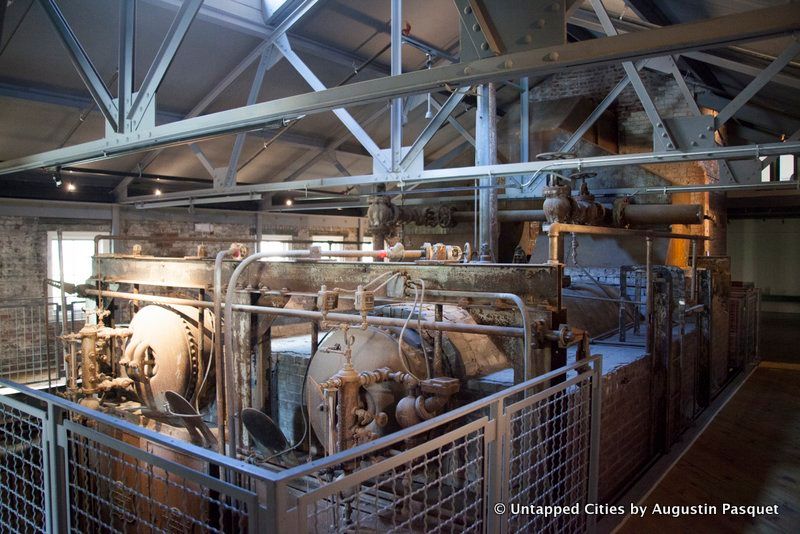
Industrial power plant preserved inside The Lace Mill
The high ceilings of the factory offer unique units ranging from studios to three-bedrooms, with many multi-level duplexes. Green initiatives abound, including Kingston’s largest solar panel array, while history has been meticulously retained – including the original power plant within, former freight train tracks, and ghost signs on brick exterior.

Main entrance of The Lace Mill
Affordable housing developer RUPCO was behind the $18.9 million renovation. The firm is active in the Hudson Valley, creating housing and community spaces for a wide spectrum of end users from artists to the elderly. Nearby, RUPCO is redeveloping a former bowling alley into affordable rentals, tech incubator and community space; and actress Mary Stuart Masterson is working on a project with RUPCO to open a film and tech production hub called Stockade Works.
Amazingly, all of the above can be seen in a weekend in Kingston but it’s certainly a city worth many repeat visits. Kingston is an easy 2 to 2.5 hour bus ride on Trailways of New York from the Port Authority. You can also take Amtrak to Rhinebeck and cross the Hudson.
Next, check out 27 Historic Estates to See in the Hudson Valley and see the abandoned Bannerman Island.
Subscribe to our newsletter